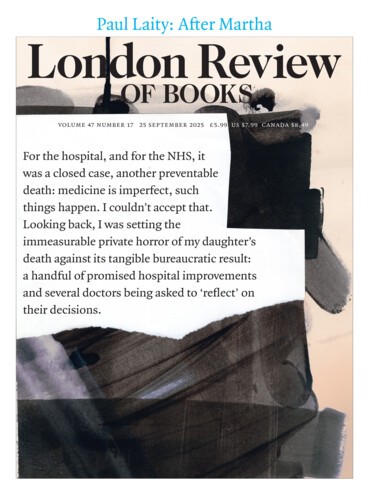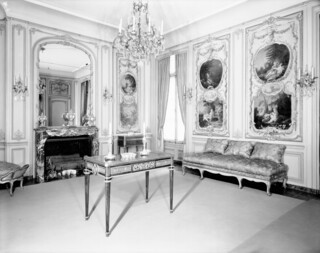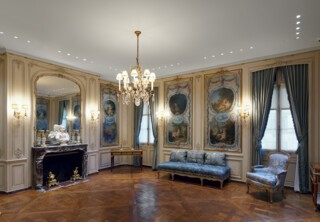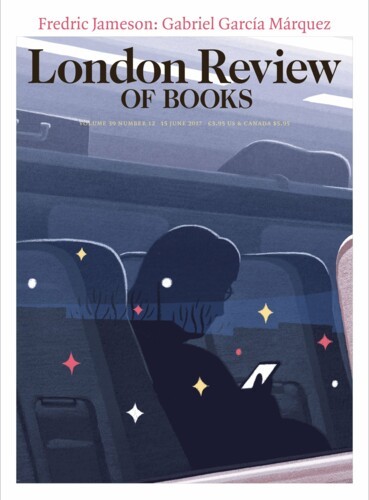Like the Wallace Collection in London, the Frick began life as a family house. In 1915, Henry Clay Frick bequeathed his Beaux-Arts limestone mansion on Fifth Avenue, along with its contents, to the city of New York. The Frick opened to the public as a museum in 1935, sixteen years after Frick’s death at the age of 69, and four years after that of his wife, Adelaide, at the age of 71. Although the museum’s holdings have nearly doubled in the decades since (partly through purchases but mainly through gifts), few public collections are so imbued with the taste and personality of a single individual.
Frick was determined to acquire nothing but the finest surviving works by the best artists and he amassed significant pieces by Holbein, Bronzino, Bellini, Titian, Veronese, El Greco, Bruegel, Van Dyck, Rembrandt, Vermeer, Hogarth, Reynolds, Gainsborough, Turner, Manet, Degas and Whistler. He wasn’t just a collector of paintings, however, and left substantial holdings of drawings, Italian Renaissance bronzes, Limoges enamels and Meissen porcelain, among other objects.
The record-breaking prices he paid for many of the works in the collection often made the front page of the New York Times. In 1911, he spent $475,000 on a portrait of Philip IV by Velázquez. But, as Frick noted to a fellow industrialist in 1895, the year he began collecting in earnest, there was ‘more real pleasure’ to be derived from buying works of art than from anything else outside of business: ‘It seems to me better to have a certain amount of such things than the same value in bonds in the Safe Deposit Company, as you can draw your dividend daily.’
Frick was born in rural western Pennsylvania in 1849 and started his coking business at the age of 21. By thirty, he had made his first million and was living in Pittsburgh, a prosperous and fast-growing city characterised in an Atlantic Monthly article from 1868 as ‘hell with the lid off’, due to the clouds of soot that billowed from the smokestacks of its many factories. How and where Frick first encountered art is unclear. But paintings – or perhaps, in the first instance, prints and reproductions – seem to have attracted him from a young age. When, in the early 1870s, Frick applied for a loan from a Pittsburgh bank, the partner who authorised it noted in his report: ‘Maybe a little too enthusiastic about pictures but not enough to hurt; knows his business down to the ground; advise making loan.’
Frick’s earliest known painting purchases date from 1881, the year he married Adelaide Howard Childs. He acquired a landscape by the French-born, Pittsburgh-based George Hetzel (1826-99) and a genre piece by Luis Jiménez Aranda (1845-1928) depicting fashionable ladies distracted by a nude statue in the Louvre. His decision to buy the Aranda (now in the Frick Pittsburgh, the museum’s sister institution) may have been sparked by his first visit to Europe, undertaken the previous year with Andrew Mellon, who would go on to form another of the great American art collections of the early 20th century.
If Frick’s trip to Europe opened his eyes to the possibilities of collecting, so, too, did his purchase in 1884 or 1885 of Mr Vanderbilt’s House and Collection: an illustrated account of the mansion erected on Fifth Avenue, between 51st and 52nd Streets, by William H. Vanderbilt, then the richest man in America. Known as the Triple Palace, the Vanderbilt mansion included a three-storey art gallery (measuring 28 by 36 feet and more than 35 feet high), which was lit during the day by skylights and at night by 169 gas jets. Shortly thereafter Frick acquired a set of twenty satin photogravure reproductions of paintings in Vanderbilt’s collection. These he hung on the walls of Clayton, the comparatively modest Italianate house he had bought in Point Breeze, eight miles east of Pittsburgh.
The mid-1890s marked a turning point in Frick’s collecting. In 1895 alone, he bought 25 paintings from Knoedler and other (mainly New York-based) dealers, spending nearly $80,000 on new acquisitions. Clayton was running out of wall space and Frick – perhaps inspired by Vanderbilt’s example – seems to have considered building an extension that would take the form of an art gallery, though he ultimately rejected the idea. Dealers, often from Knoedler (which, thanks chiefly to Frick’s patronage, opened a branch in Pittsburgh in 1897), now started accompanying the family on what had become regular expeditions to Europe. Over time, Frick gravitated from the work of 19th-century artists – such as the French landscape painters of the Barbizon School, whose works were much sought after by Pittsburgh’s smart set – to Old Masters. On one or more trips to Europe in the early 1900s, he visited the Wallace Collection, which had been bequeathed to the nation in 1897 and opened as a public art museum three years later.
Frick had the nous to insist that dealers allow him to trade back pictures he had outgrown, enabling him to upgrade his collection on a regular basis. He studied the art market closely, tracking the prices of paintings by Turner, for example, long before he acquired one himself. Frick’s daughter Helen later recalled that he moved through art galleries ‘like a streak of lightning’, but ‘remembered more than the rest of us … his powers of observation were remarkable’. His competitive instincts helped him to outbid, outmanoeuvre and generally outdo rival collectors.
In 1905, the Fricks left Pittsburgh for New York. They were able to rent the Triple Palace for $50,000 per year and Frick seems to have briefly toyed with the notion of buying and renovating the mansion. In the end, however, he decided to build his own palace on a plot of land some twenty blocks further north on Fifth Avenue, not far from the Metropolitan Museum of Art. Builders broke ground on the property in 1912, the same year Frick acquired what has become one of the most celebrated works in the collection: Holbein’s portrait of Thomas More. (In due course, he would display it juxtaposed with a portrait by Holbein of Thomas Cromwell, so that each man appears to be eyeing his adversary.) Designed by Thomas Hastings of Carrère and Hastings, the same architectural firm responsible for the New York Public Library, work on which had been completed in 1911, the layout of the Frick mansion was intended, first and foremost, to showcase Frick’s collection of paintings and other works of art. In 1914, two years’ worth of building works came to an end and the Fricks moved in.
The ground floor contained the house’s public spaces. Guests moved through a series of increasingly grand, high-ceilinged rooms, from the dining room to the drawing room to the living hall (where the Holbeins hang on either side of the fireplace) to the library and finally to the long gallery. This last, designed to be the climax of the visitor’s experience, was 96 feet long and almost 34 feet wide, making it (at the time) the largest private art gallery in New York. Frick’s rival collector Benjamin Altman, who died in 1913, leaving his holdings to the Metropolitan Museum of Art, owned a mansion at 626 Fifth Avenue, in midtown Manhattan, with a long gallery that measured 90 feet. Frick got one of his contacts at Knoedler to find out the dimensions of Altman’s gallery to make sure his would be longer.
With the exception of the long gallery, which was lit by skylights, the reception rooms on the ground floor were illuminated by large windows or French doors. Frick’s office was initially located just off the western end of the long gallery, until, in 1916, he vacated that space so that it could be used to display a collection of Limoges enamels acquired from the estate of another rival collector, J.P. Morgan, who had died in 1913. Vertical display cases were duly built and the room transformed into a cabinet, with some enamels laid out on tables and dressoirs. Many American collectors of the Gilded Age sought to recreate an Italian Renaissance studiolo, but Frick was unusual in having created a French Renaissance room.
The mansion’s first floor constituted the family’s private living quarters. Its rooms were smaller and more intimate, with lower ceilings, and were hung with more modest pictures. Prior to the museum’s recent renovation – completed in April at a cost of $330 million – this floor was used for curatorial offices and was off-limits to the museum-goer. Now, the velvet rope at the base of the grand staircase is gone and the domestic spaces are opened up to the public. At the top of the stairs, an extraordinary ceiling mural depicting cavorting monkeys in 18th-century dress, executed c.1914 by John Alden Twachtman, who took inspiration from similar murals painted c.1730 by Christophe Huet at the Château de Chantilly, can now be admired. Elsewhere, architectural features – ranging from decorative marble and plasterwork to wood panelling and carvings – have been restored by specialist craftsmen. Period textiles and upholstery have been painstakingly recreated, where possible in collaboration with the firms that produced the original fabrics.
Opening up this floor has nearly doubled the available display space. Previously, 25 per cent of the permanent collection was on view at any one time; now, that figure is just under 50 per cent. The relatively compact size of the rooms in the family quarters makes them ideal for the display of small objects, meaning that the museum’s holdings in the decorative arts – including several recent bequests – can be showcased in a way that would have been impossible before. What was once Adelaide Frick’s bedroom now houses a collection of faience given to the museum, while another former bedroom displays some of the 450 portrait medals, spanning from the 15th to the 19th centuries, recently left to the museum. In what was the office of Frick’s private secretary, recesses that originally held filing cabinets are now filled with climate-controlled, glass-fronted cases displaying a bequest of clocks and watches.
The renovation of the family quarters has also made it possible for some objects previously displayed on the ground floor to be returned to the rooms they occupied when the Fricks were in residence. A portrait of Emma Hamilton by George Romney, which for many years was displayed in the living hall, now hangs over the fireplace in Frick’s bedroom, as it did during his lifetime. The contents of the Boucher Room (so-called because its focal point is a series of mid-18th-century panels by François Boucher and his workshop) have been moved back to their original location in Adelaide Frick’s private sitting room. Meanwhile, the space on the ground floor which, for decades, served as the Boucher Room – and which originally was a cloakroom – is now used for rotating displays of drawings.
The opening up of the private quarters is the most thrilling aspect of the recent refurbishment and expansion: I can’t be the only visitor to the Frick to have stood at the bottom of the grand staircase longing to know what lay upstairs, on the other side of the velvet rope. The restoration of the upper floor, however, is only one piece in a much larger jigsaw overseen by Annabelle Selldorf (whose architectural firm was also responsible for the recent revamp of the National Gallery’s Sainsbury Wing) and Beyer Blinder Belle, specialists in historic preservation. There is now an expanded visitor entrance hall which – thanks to the addition of a second level, created by raising the ceiling height of the existing 1977 structure – feels much lighter. There are also three new galleries on the ground floor dedicated to special exhibitions, meaning that it will no longer be necessary for works from the permanent collection to be placed in temporary storage to free up wall space. There is a new lecture theatre; a dedicated room for public education programmes; a gift shop twice the size of the last; and the museum’s first restaurant, overlooking and offering new views of the 70th Street garden (which has been returned to its original design). Behind the scenes, the museum’s conservators now have a state-of-the-art studio, having previously worked in a small room in the old servants’ quarters with no running water.
The Frick Art Research Library (FARL), established by Helen Clay Frick in 1920 as a memorial to her father, has had a make-over, too. Just as the Wallace Collection seems to have provided Frick with a model for the way a family house and its art might become a public museum, so Helen took inspiration from an example encountered in London: the library of Robert Witt, whose collection of photographs of paintings would later become the Witt Library at the Courtauld Institute. For the FARL, Helen commissioned photographers to document objects in churches, private collections and other obscure places throughout Europe, information which was used during the Second World War to annotate the maps given to Allied bomber pilots in the hope of minimising the destruction of significant monuments and artefacts. As part of the recent renovation, the reading rooms have been refurbished and the flow of traffic between them and the museum’s exhibition spaces has been improved: changes designed to bring the FARL and its contents (which now run to 1.5 million images) to the attention of a wider audience.
It is an achievement which ushers the Frick into the 21st century while maintaining, for the visitor, the sense of being a guest in a (very opulent) family house in the first decades of the 20th century. Very little is roped off, signs are kept to a minimum and many small sculptures and ceramics are displayed on tables or open shelves rather than behind protective glass. Photography is banned.
Send Letters To:
The Editor
London Review of Books,
28 Little Russell Street
London, WC1A 2HN
letters@lrb.co.uk
Please include name, address, and a telephone number.



